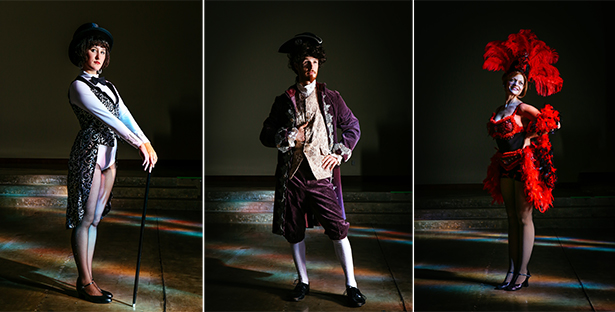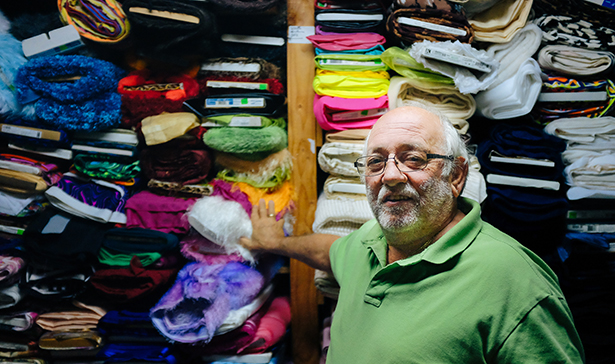
“A costume designer is a bit of a hoarder,” says Sandy Bonds, professor of costume design at the University of Oregon since 1979, adding, “an organized hoarder.”
“This is our own Value Village!” Bonds says as she unlocks a storage room in the basement of Villard Hall on the UO Campus. Inside hangs a huge collection of wearable treasures, mostly hand-constructed and all lovingly preserved.
“My job as a designer is to draw, select, purchase and pattern,” she says. “Yes, I shop at thrift stores, and we make our own things. We build and sometimes we rent.”
Showing off her large, bright studio in the newly renovated Miller Theater Complex, Bonds speaks fondly of the many former students who are now actively costuming around Eugene, like Shedd Theatricals costume designer Jamie Parker.
“Costumes take you to a different time and place,” Parker says. “They take you out of your reality to where the story is being told.”
Jonna Hayden is another of Bonds’ former students who now teaches costuming at Springfield’s A3 School and has recently done work for the Eugene Ballet and the Eugene Opera. “Clothing is communication,” Hayden says. “There’s nothing onstage on any actor that’s not a choice. It should always explain who the actor is and enhance the story.”
 |
| Designs by Jamie Parker of Costume Couture |
Hayden and Parker both cite the creative challenges in costuming for opera and ballet, as the designer has to take into consideration the movement and stress on apparel when performers act, dance and sing. Garments must move; they have to hold up for repeated performances and washings, and be economically feasible to put together.
Jeanette deJong, another of Bonds’ former students, concurs. “We’re always working on a budget,” she says. “You have to be more thoughtful.”
deJong, who designs for the Eugene Opera and Oregon Contemporary Theatre, often re-tailors thrift store finds to fit a particular historical period. “When you go to Goodwill, the question becomes ‘How do I make a look out of what I get?’” she says.
Audiences might not notice the planning that goes into costumes, but every choice onstage has purpose and meaning.
Designer Erin Schindler, who makes costumes for Oregon Contemporary Theatre, describes the visioning process at the outset of any production. “We meet the director, read the script, do historical research and start drawing it out,” she says. For Schindler, costumes are most often “shopped, pulled and altered,” but there’s an artistic finesse to this approach, even if garments aren’t always built from scratch.
Every costumer I spoke with said she became interested in sewing as a child, inspired by a family member or teacher. But in an increasingly ready-to-wear world, it’s hard to know where the next generation of “stitchers” will come from.
 |
| ACE’s Joe Zingo |
“Sewing is a lost art,” says Actors Cabaret of Eugene’s Joe Zingo, who’s been designing and sewing costumes for longer than he’d care to see in print. “We all take pride in what we present,” he says. “Here, our pride is in the details.”
“Costuming is a set of skills, design is a set of skills, knowing color, fabric and texture is a set of skills,” Zingo says. “You have to know what a fabric will do, under stress, movement, when it’s dyed or distressed. You have to know whether it will suggest wealth or poverty. You have to know about the styles of clothing and their silhouettes.”
“It’s challenging, but rewarding,” says ACE volunteer Mary Jensen. Retired from a theater background, Jensen says she is delighted to be sewing for an appreciative community theater. “The actors put the costumes on,” she says, “and they become their character more fully.”
Costumers rely on go-to staples like safety pins and hot glue — even duct tape in a pinch — to help them find quick and easy workarounds. And their work is hardly static.
Responsible for coordinating all the backstage outfit changes, costume designers create flight patterns for actors moving swiftly from scene to scene. If it goes smoothly, audiences will never know what a frantic dance is taking place offstage.
Whether building, borrowing or buying the pieces that will help to tell the play’s story, “Costumers figure out puzzles together,” says Dody Hansen, volunteer costume designer with Rose Children’s Theatre. “It’s about teamwork. And a quick change with a 7-year-old can be quite interesting.”